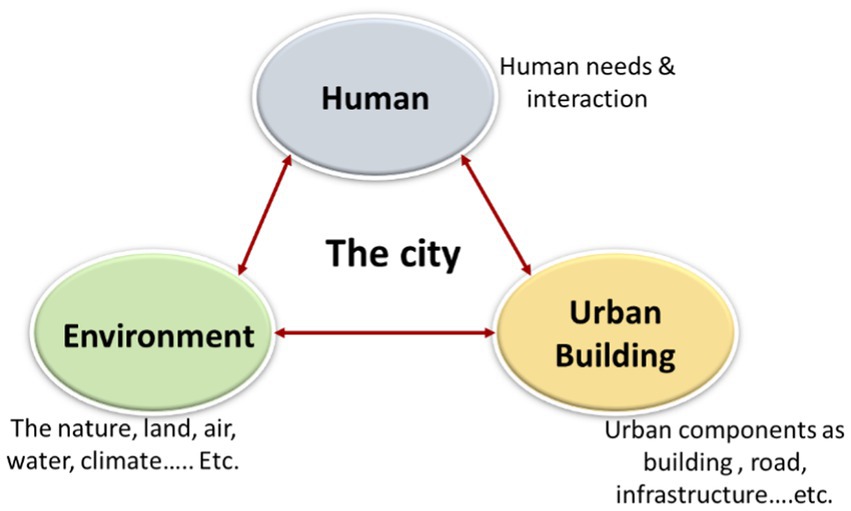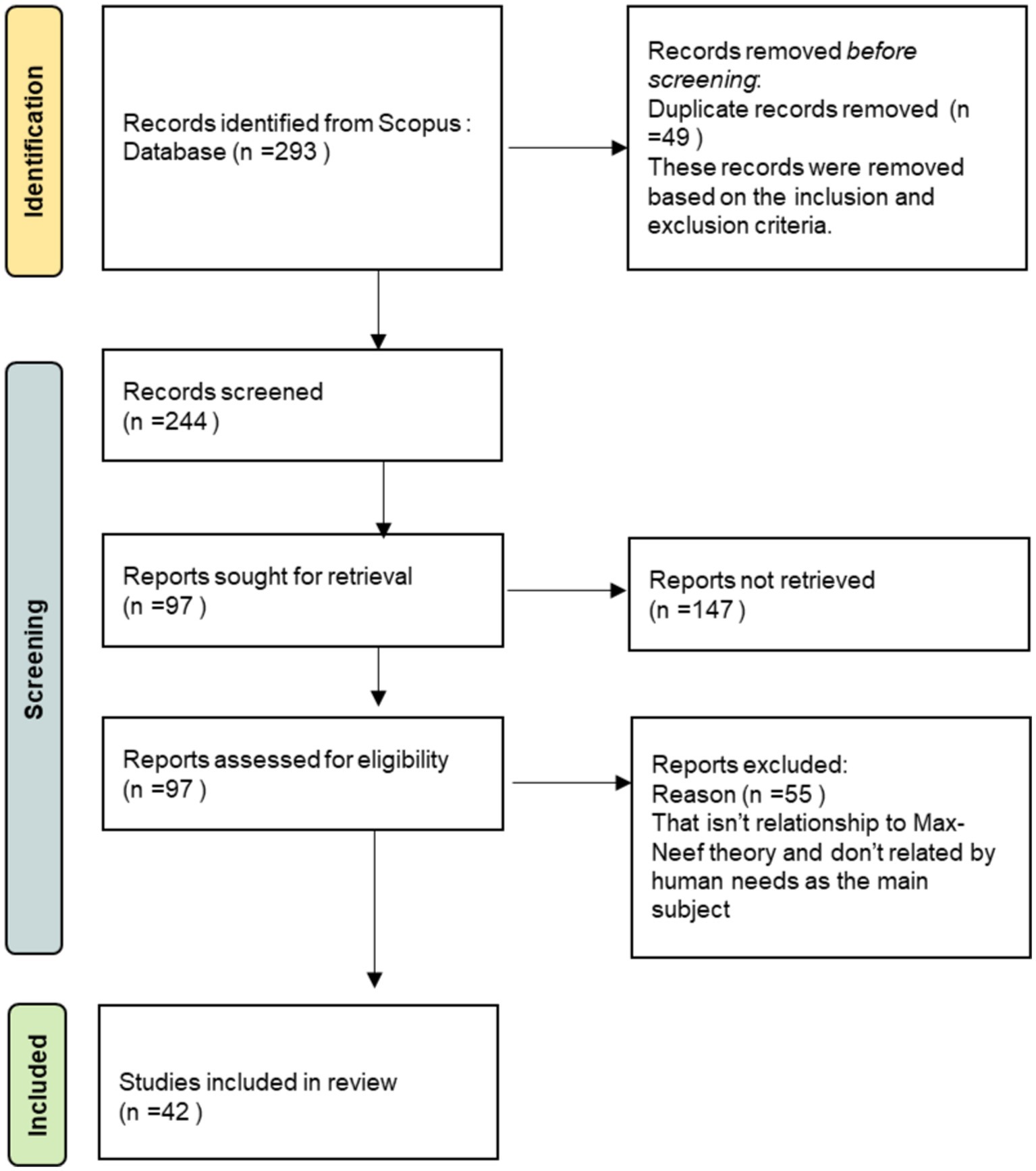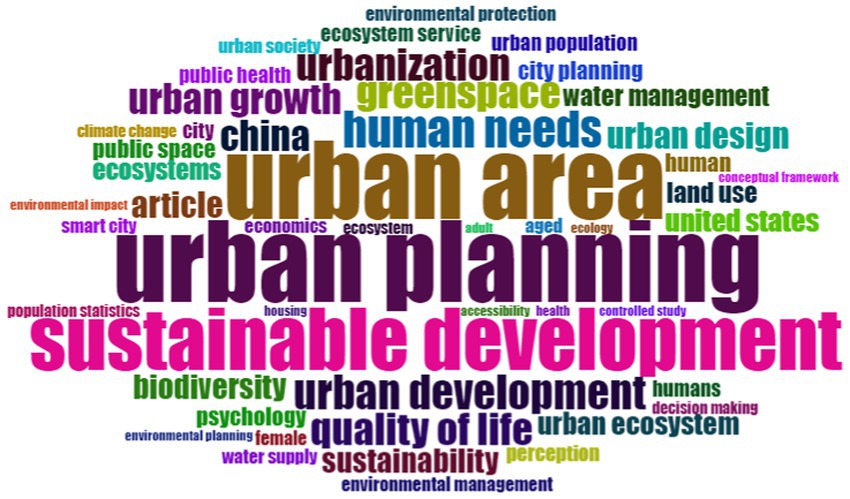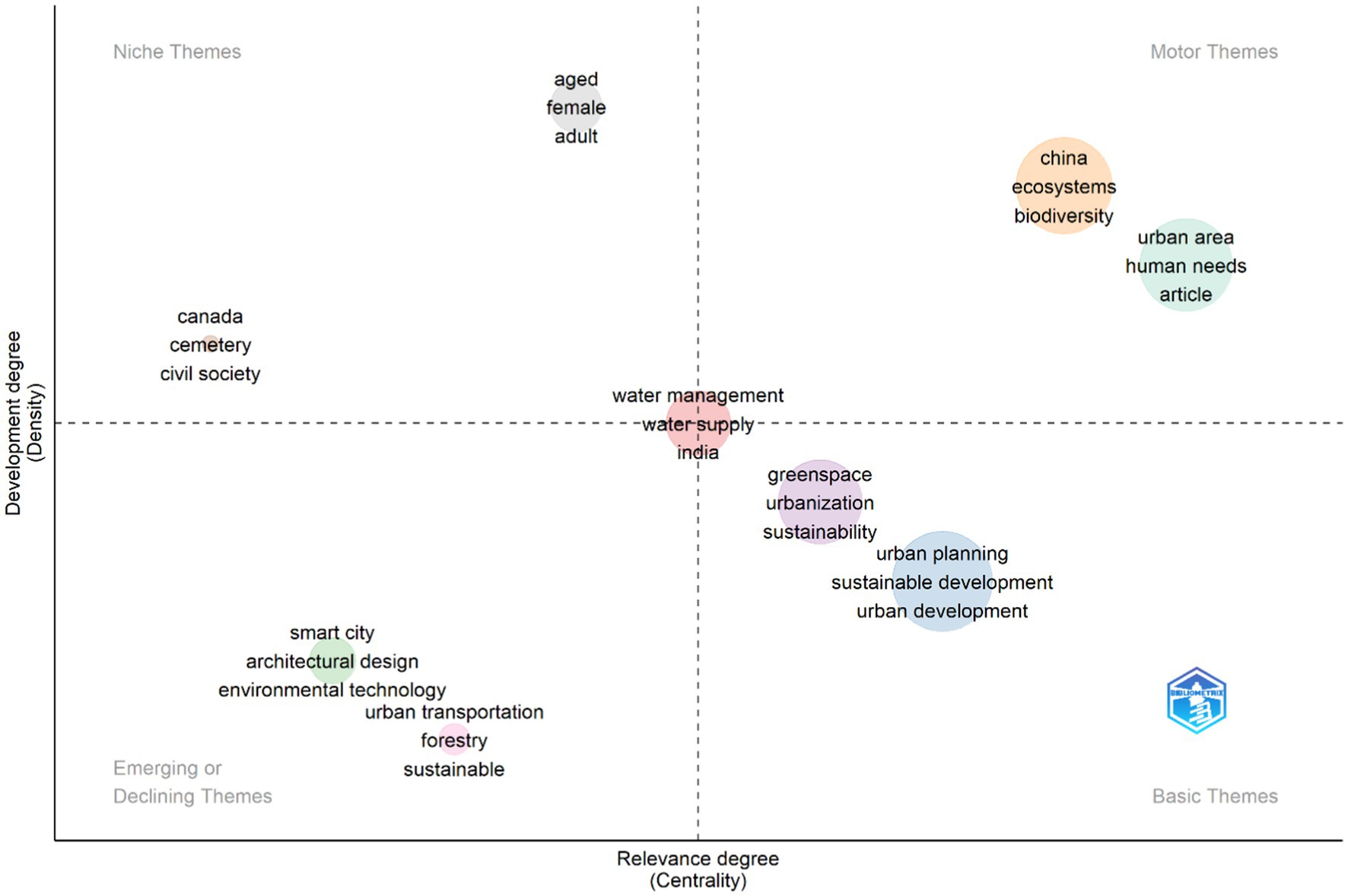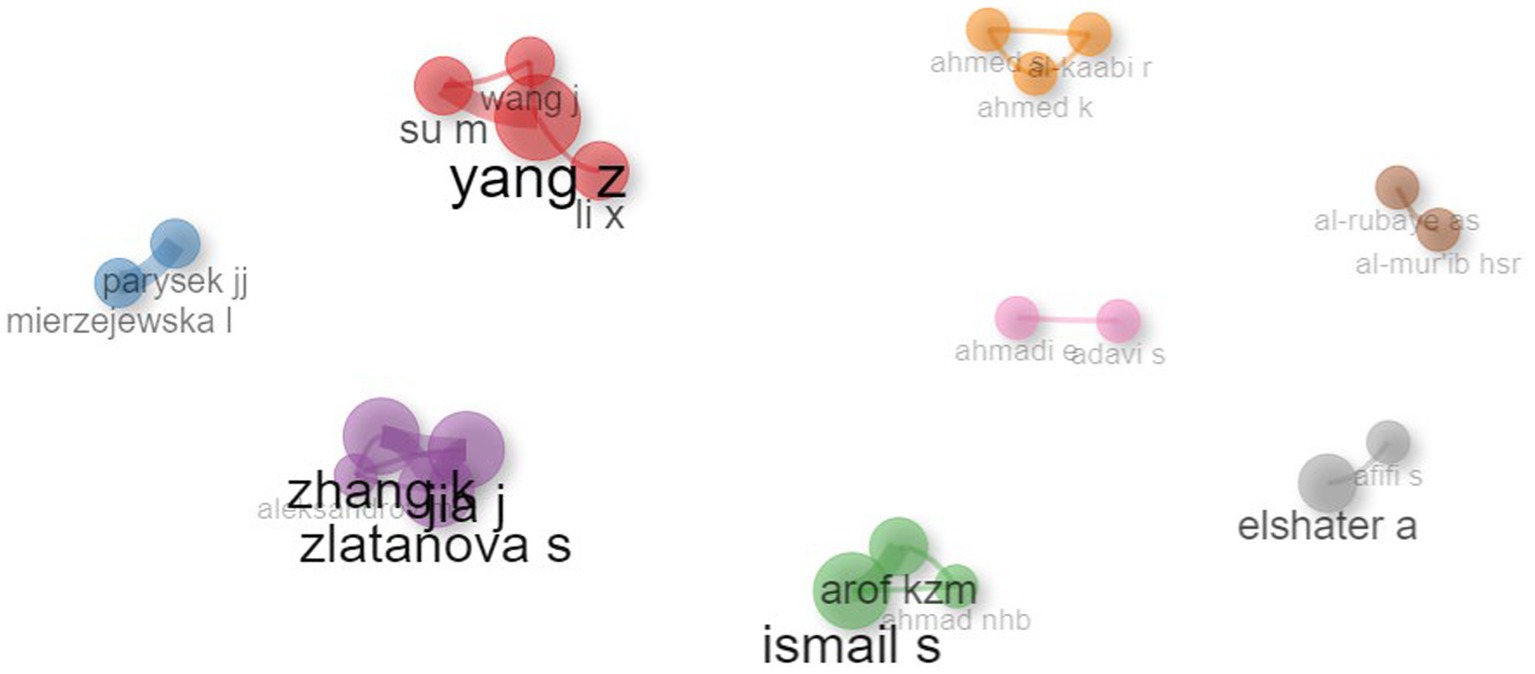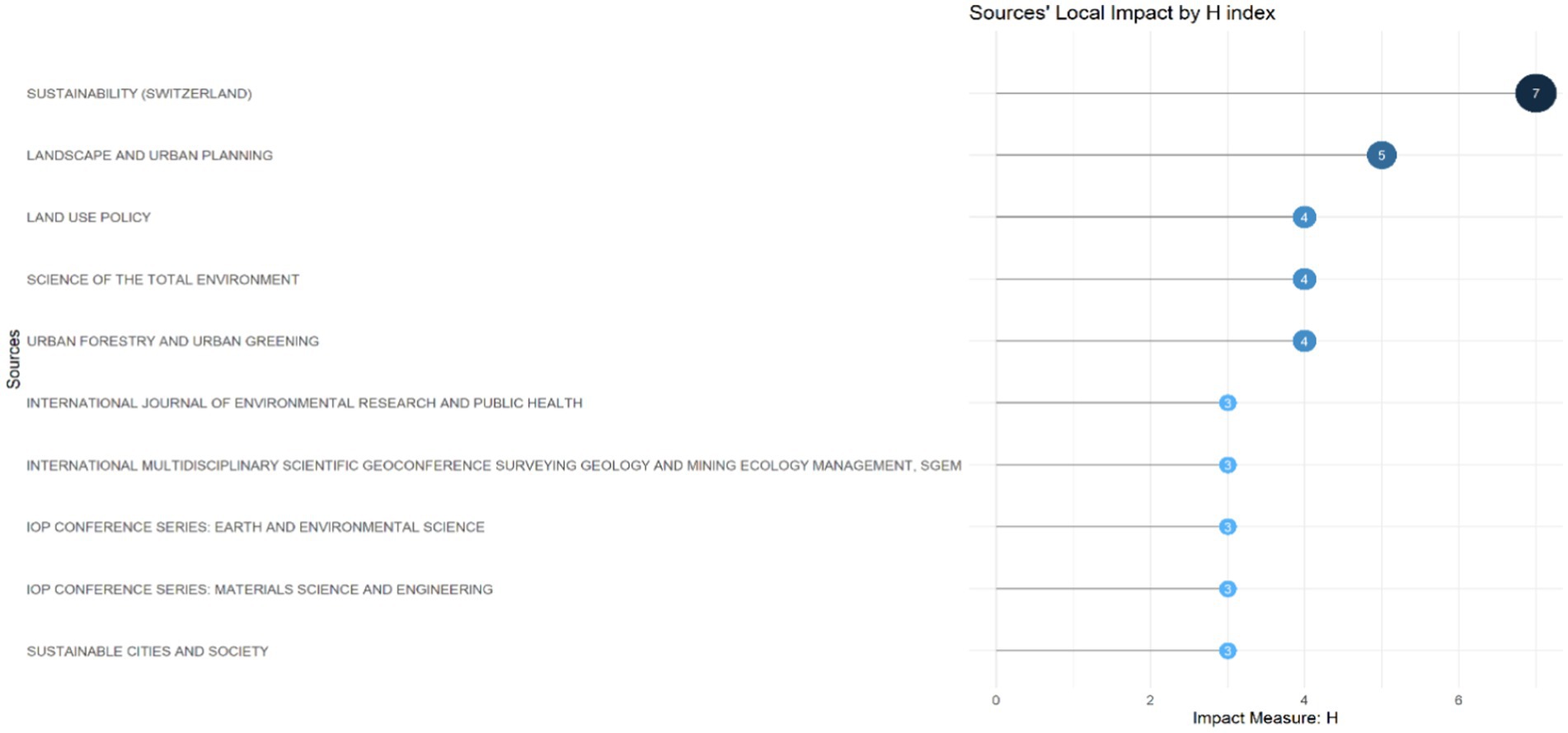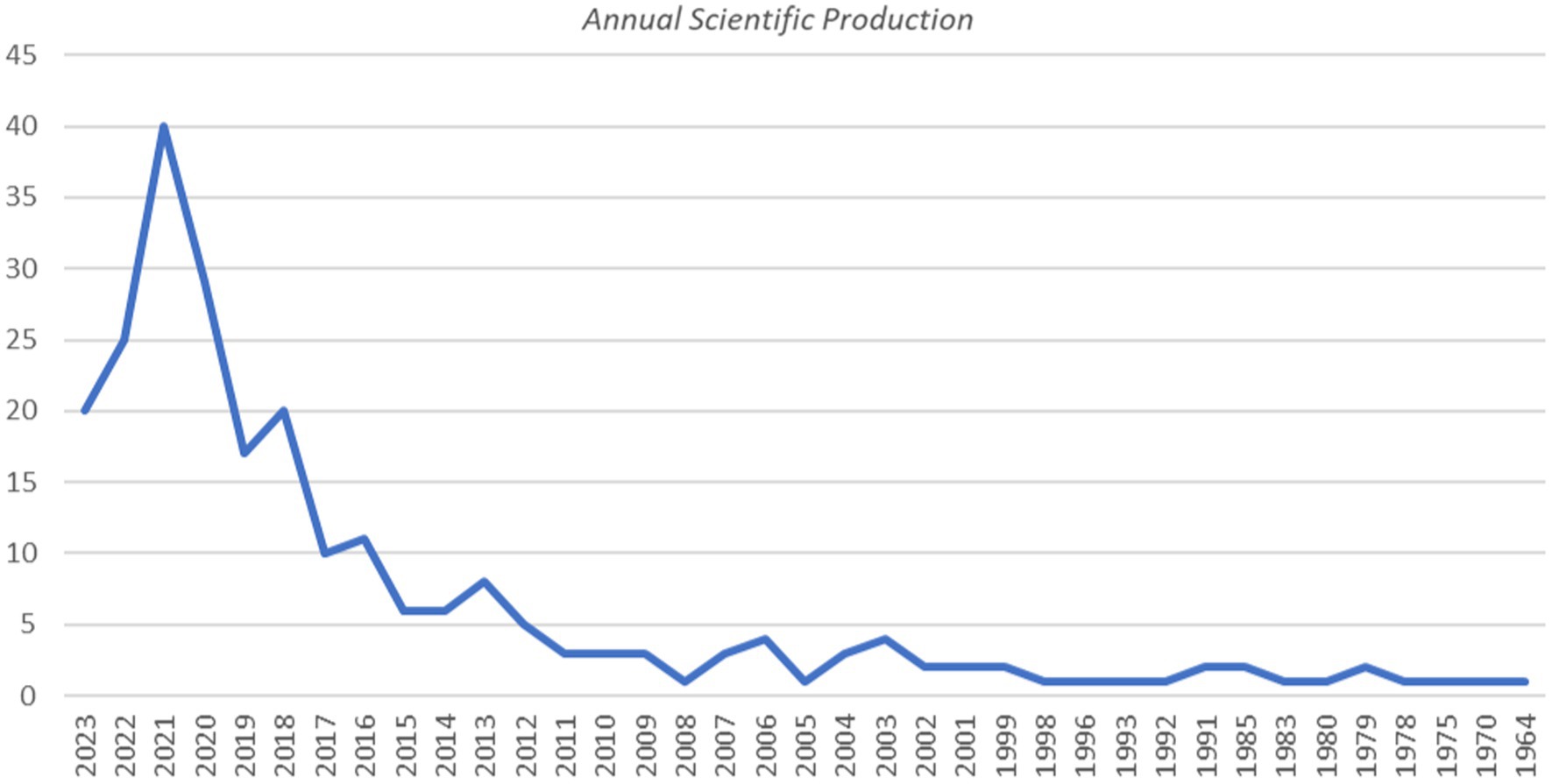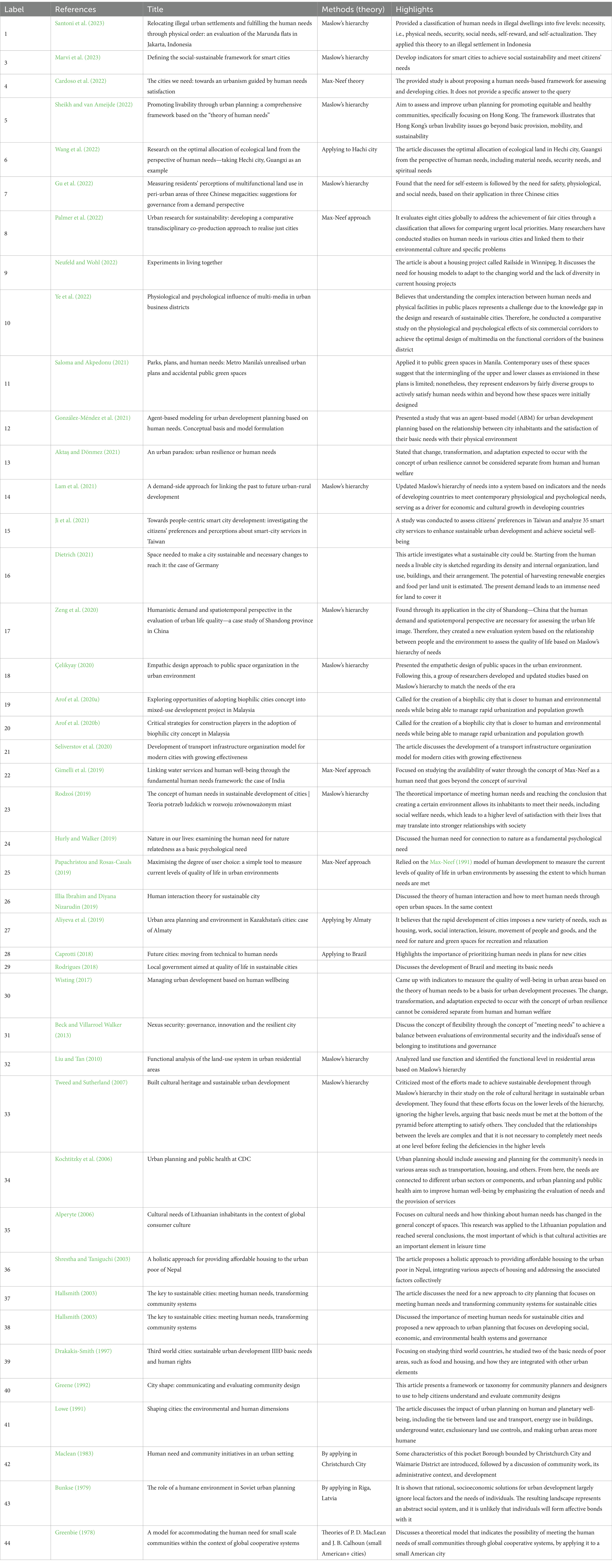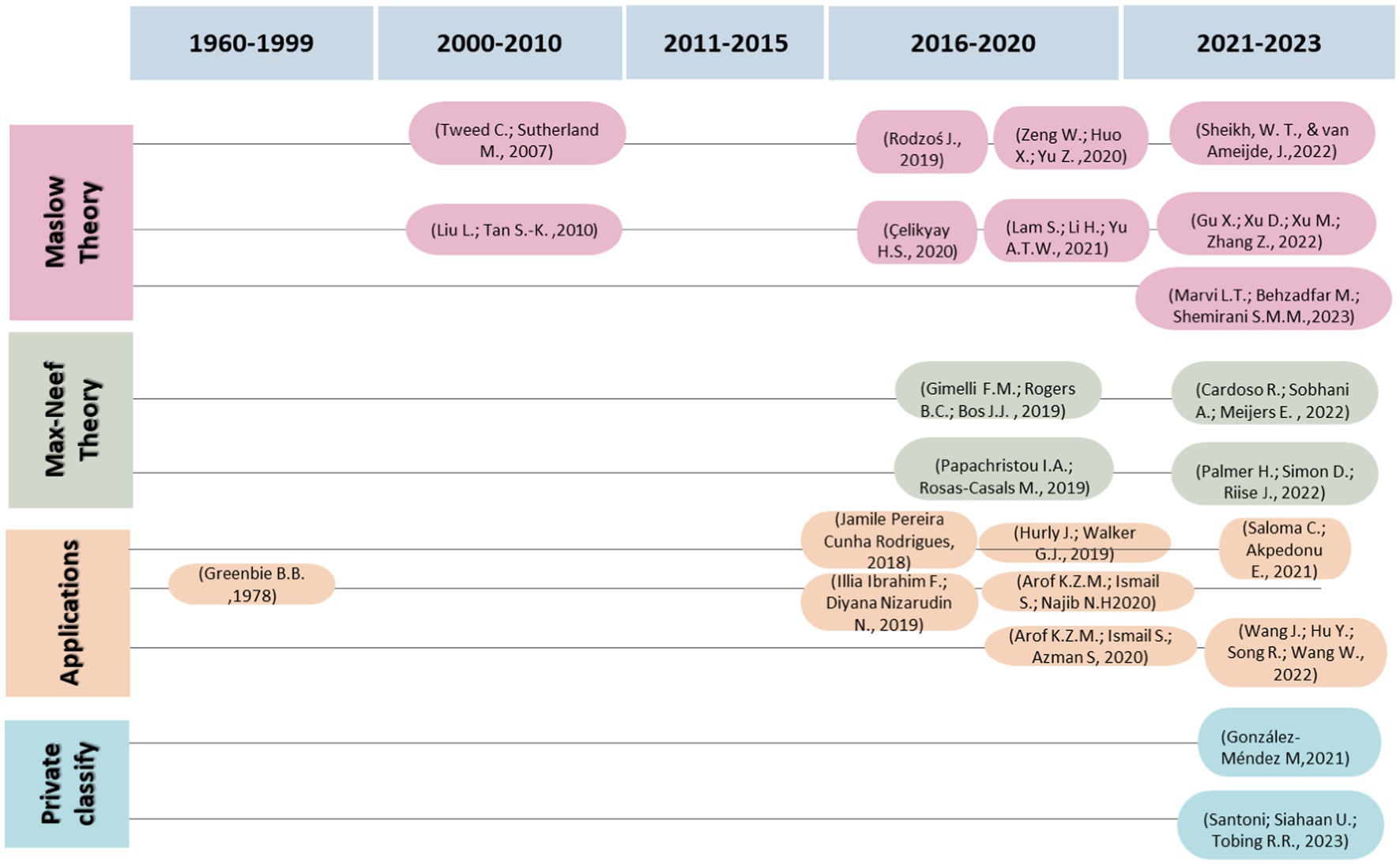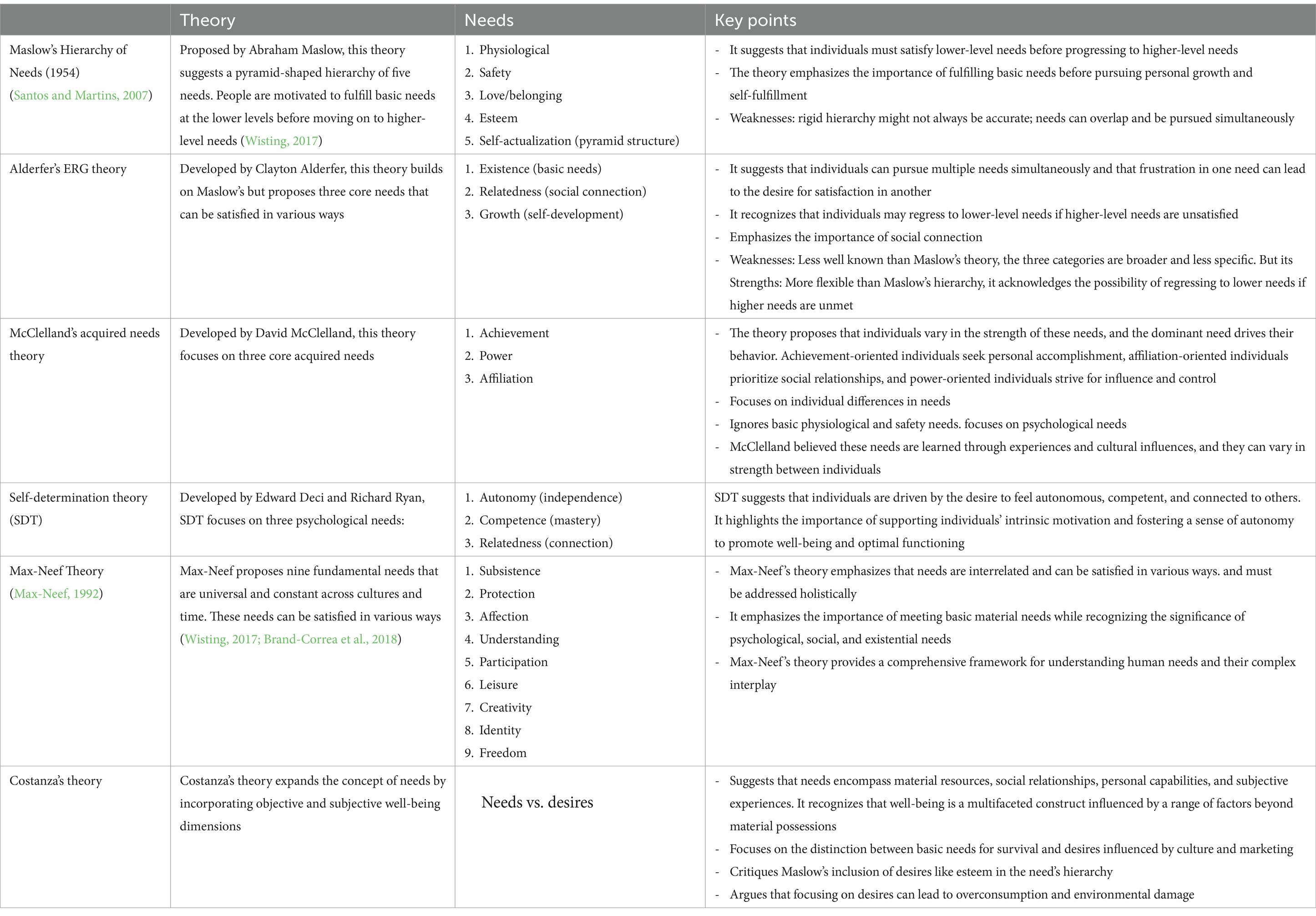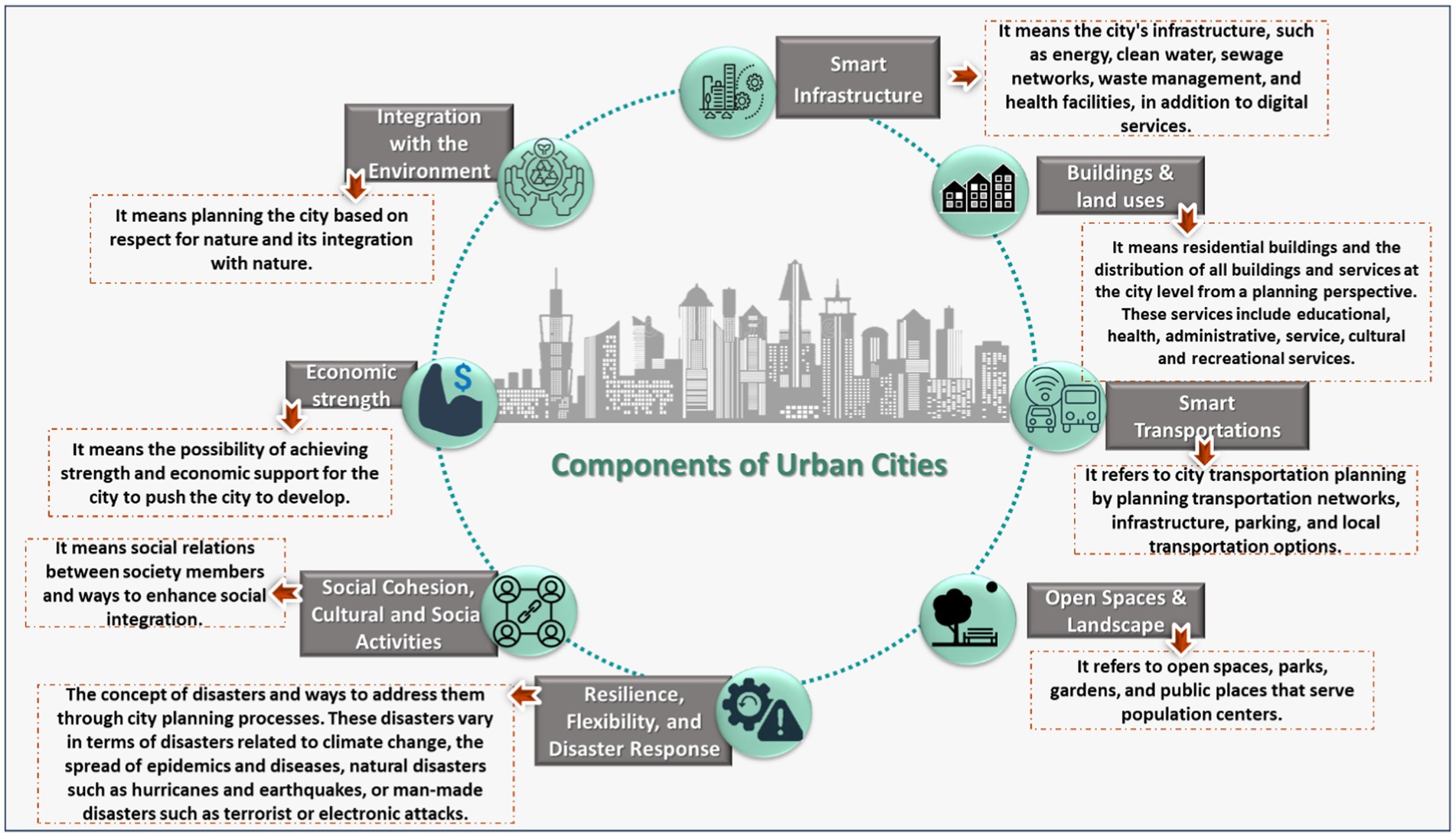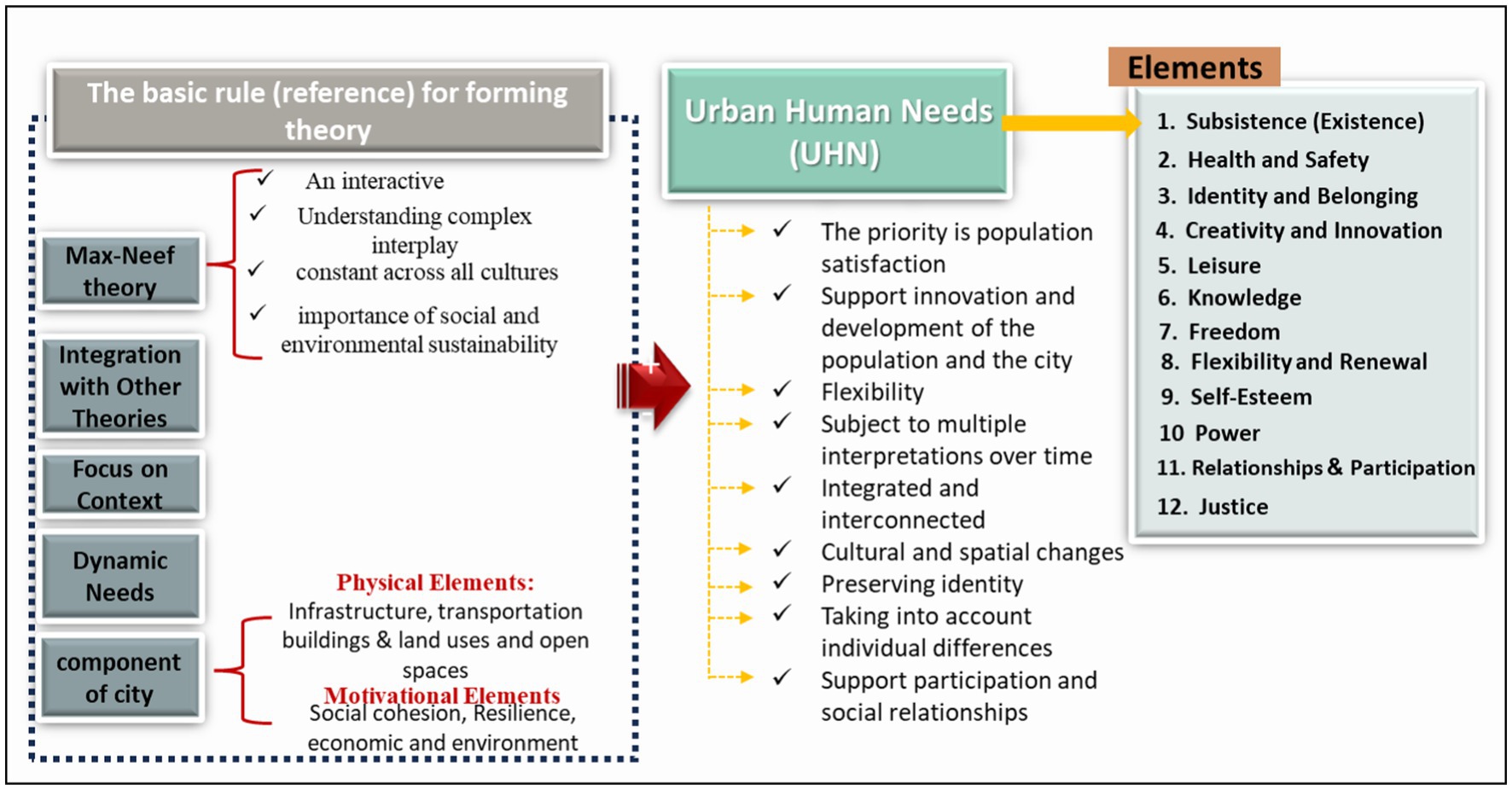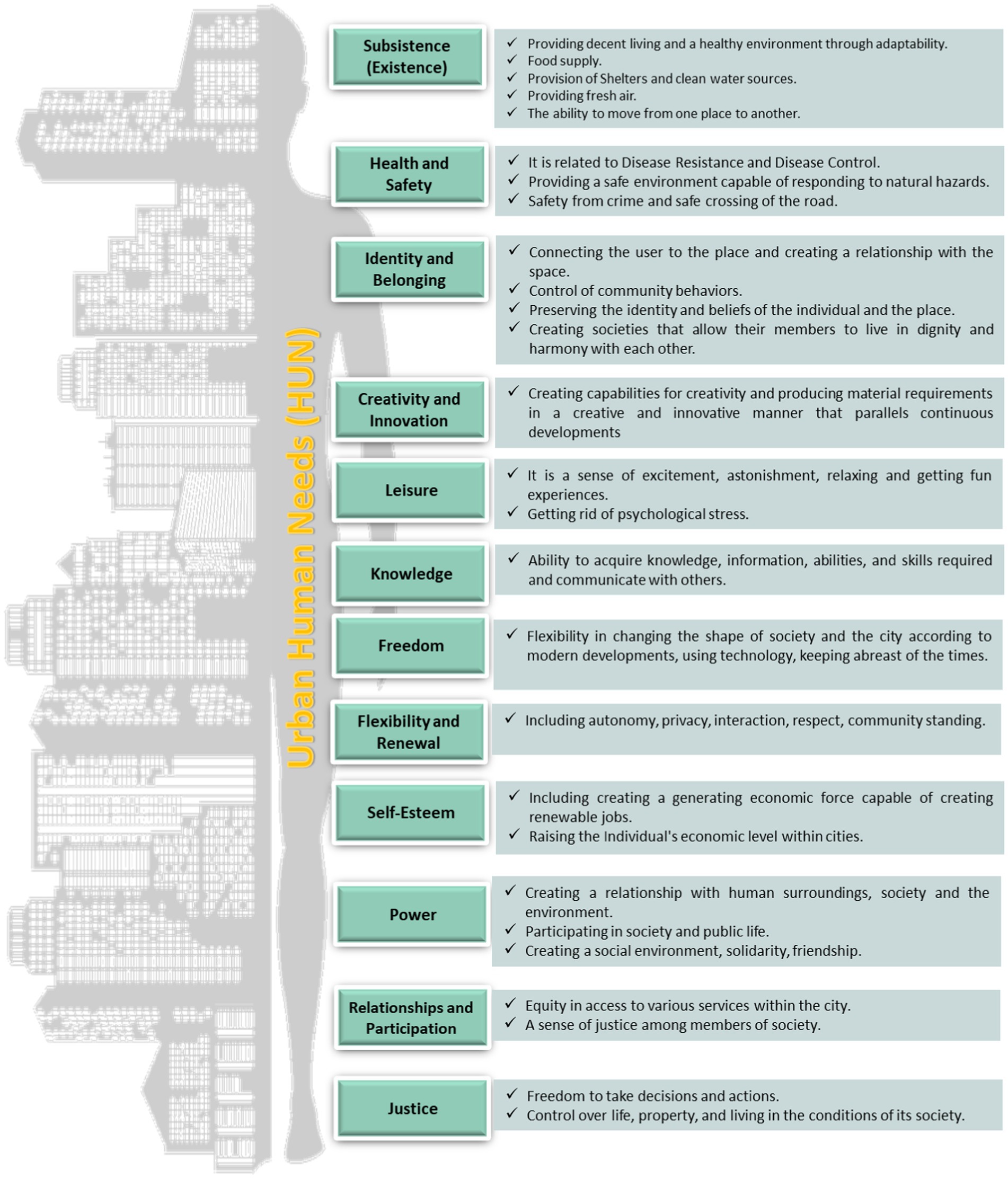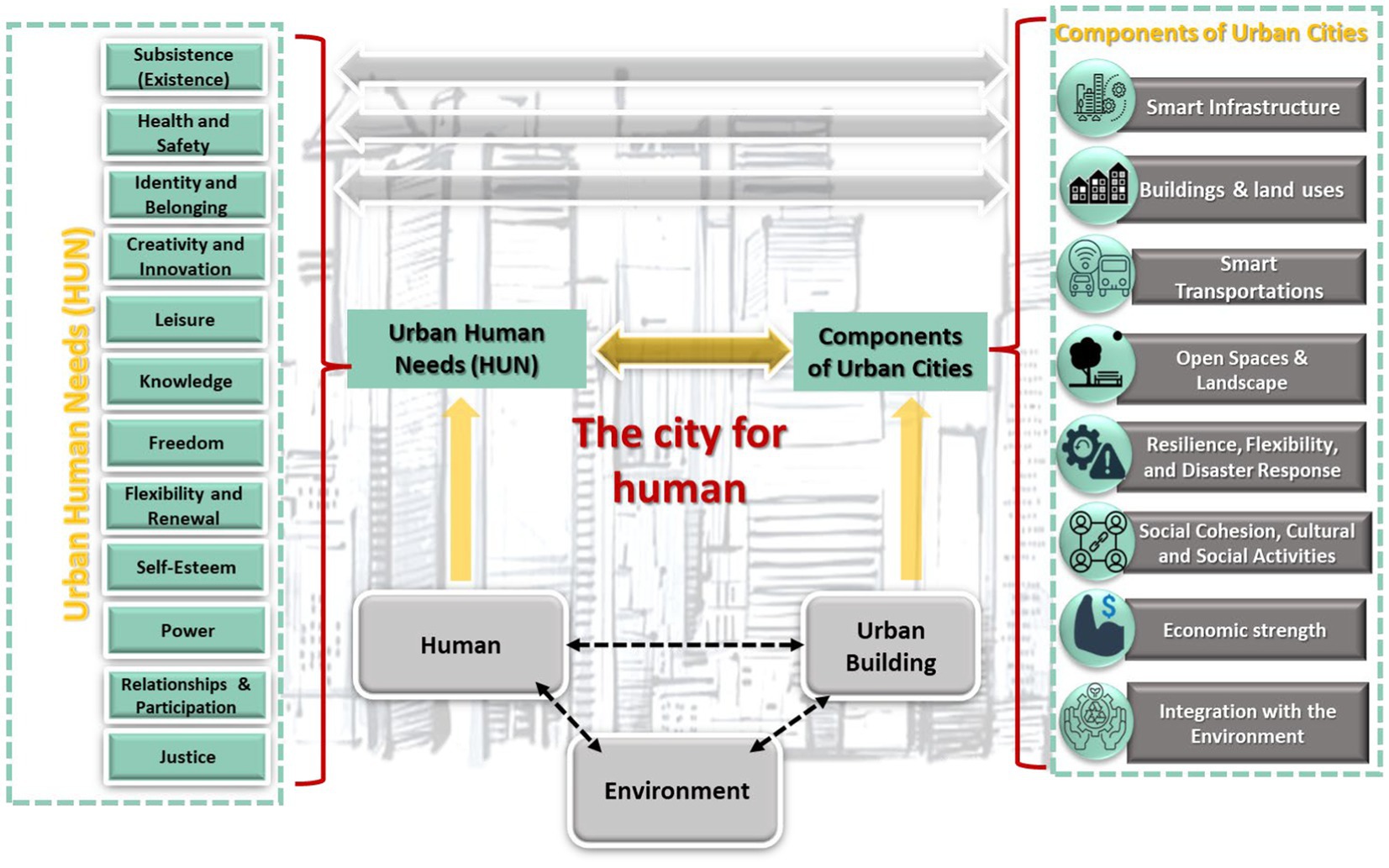- Department of Architecture Engineering, College of Engineering and Information Technology, Buraydah Private Colleges, Buraydah, Saudi Arabia
Cities have been created to meet human needs, but creating sustainable societies has become a major challenge in light of the planners’ broad interest in creating smart cities or giving exclusive priority to the environmental dimension of sustainability. This is one of the goals related to sustainable development (SDGs) and therefore, the human perspective of urbanism is considered a future challenge in achieving (SDGs). The research aims to bridge the gap in previous studies and highlight the integration of human needs in plans for urban human cities. It also aims to create a conceptual framework that leads to a new theory of urban needs by bridging the knowledge gap in previous studies by considering modern numerical analysis tools, Thus, a bibliometric analysis based on the Biblioshiny and VOSviewer tools within the scope of human needs and urban cities promotion was accomplished. Next selecting evaluation criteria for human needs through a comparative critique of the most important theories of human needs. Then deducting the new theory of urban needs and linking it to the elements of urban composition. Results have reached a new framework that clarifies the human needs that need to be achieved and links them to the urban components to create an integrated urbanization that fulfills the desires of the population. This research serves as a reference for reevaluating urban directions and modern theories that aim to develop future cities. It also helps evaluate cities, envision future human needs, and achieve future prosperity for cities.
1 Introduction
The concept of human needs is extremely valuable in maximizing the potential of individuals as drivers of sustainable development. it will result from that by creating living conditions that enable residents to satisfy their needs, including social well-being and empowerment, it can lead to higher levels of life satisfaction. Consequently, this may strengthen the bond between individuals and their place of residence, as well as their willingness to take action in favor of the overall living environment (Rodzoś, 2019).
The exaggeration in implementing the idea of modern trends in cities has overlooked the primary goal of establishing these cities, which is the human being and his needs through urbanization. Many of these trends think of the city only from an economic perspective (Gibbs et al., 2013), which is an unfair view as they seek to find solutions to the technical and economic problems of the future and the marginalization of humans and their current social problems. It will result from the application of these trends in the future, as it is based on dealing with cities from a narrow and limited perspective, such as the technical and economic perspective (Rossi, 2016; Caprotti, 2018), which works to reshape cities by applying modern technologies under the pretext that they facilitate life (March and Ribera-Fumaz, 2016), and working to raise economic efficiency, so cities became viewed as a set of technical problems that must be solved through applying digital technologies as an economic opportunity for governments and technology companies (Caprotti, 2018).
The focus of these trends on one aspect of city planning was that they did not provide solutions to the emergence of diseases and epidemics such as COVID-19. It showed the flaw in governments’ control over the built environment and did not provide health and safety for citizens. Indeed, there has been an outbreak in many cities as climate change continues to this day, with the presence of global warming problems and the emergence of many social and economic problems such as unemployment, disparity in the classes of society, increased poverty in many countries, the occurrence of social isolation, and a decrease in community interaction and participation among residents and decision-makers as well.
Hence, the importance of creating cities that meet human needs and integrate them as a priority in urban planning. This is achieved by answering several questions:
1. How important is it for researchers to study human needs in urban planning, and what is the research gap?
2. What is the meeting point of theories of psychology and sociology in studying human needs with the formation of urban cities?
3. What is the concept of urban human needs (UHN)?
4. How do integrate urban human needs with the formation of urban cities?
The research aims to bridge the gap in previous studies and highlight the integration of human needs into plans for urban human cities (UHN). It also aims to create a conceptual framework that leads to a new theory of urban needs. As shown in Figure1, the rest of this article is organized as follows. Section 2 provides variables for UHN. Section 3 presents the method of theoretical base that is related to bibliometric analysis based on both the Biblioshiny and VOSviewer tools within the scope of human needs and urban cities. Followed by a focus on theories of human needs and choosing criteria for assessing human needs and determining urban components in Sections 4 and 5. Section 6 highlights the concept of HUN. Section 7 discusses the research results and finally, Section 8 presents the conclusion.
2 Variables for UHN
Cities are complex and dynamic systems (Fan et al., 2023). It depends on several variables, as shown in Figure 2, and the relationship between humans, urbanism, and the environment is considered the primary driver of the formation of cities. Human needs refer to a set of personal, economic, social, and political requirements for people to avoid serious harm, achieve their goals, live fulfilling lives, and participate in societal development (Tay and Diener, 2011; Mutică, 2013; Cardoso et al., 2022).
Urban components are various facilities within the urban management public area (Zhang et al., 2019), the relationship between human needs and the components of urban cities is complex, but it is clear that there is a strong interconnection between both of them. Human needs and the components of urban cities are closely linked, as the design, planning, and development of urban areas aim to meet human needs and improve their quality of life. Urban city components refer to the physical and social elements that make up a city, including buildings, infrastructure, transportation, public spaces, and social institutions. Needs, on the other hand, refer to the necessities and wants that people have for their physical, social, and emotional well-being, such as access to clean water, food, shelter, education, healthcare, social interaction, and cultural activities. Urban design and planning must take these human needs into account to ensure that city components respond to the needs of their residents.
The concept of the modern city and its definition as an economic and social system has sparked criticism. Bunkse (1979) argues that this definition is narrow and fails to address basic needs. Ignoring local factors and individual needs results in a social system devoid of any emotional connections with its members. In response, Maclean (1983) proposes initiatives to develop communities in the Riccarton area of Christchurch, focusing on meeting human needs through community work and development. Lowe (1991) discusses the inability of poorly planned urban areas to meet human needs by reviewing issues faced by both industrialized and developing countries, such as transportation, energy, water, housing, services, employment, and conditions necessary to make cities more humane. Following this, Shrestha and Taniguchi (2003) emphasized studying the provision of affordable housing as a basic need. Focusing on studying developing countries (Drakakis-Smith, 1997) conducted a study on two basic needs of impoverished areas, such as food and housing, and how they integrate with other urban elements to improve the quality of life in urban areas.
Ji et al. (2021) argued that there is a research gap in experimental studies that specifically focus on the needs and preferences of citizens regarding sustainable urban services. There seems to be a lack of ability to design for the complexity of human needs and values (Luckan, 2021). This was demonstrated through several international experiences, including the Paris experiment, where a local bike-sharing project was implemented for 5 years to reduce congestion and pollution. However, citizens perceived this project as ineffective because they believed that air pollution was not a problem in Paris (Bris, 2019).
Hence, scientific research began to focus on city planning from a different perspective, including (Mutică, 2013) who believes that modernist ideas in building cities are less than perfect. A dialogue is needed with sociologists, psychologists, and anthropologists when planning to create a new vision, which is to begin studying the needs of individuals. Thus, he submitted a study on the most important human needs that architecture must meet.
Consequently, research has turned toward incorporating the concept of meeting human needs in urban development plans, after being overlooked in modern urban trends. Seliverstov et al. (2020) have established that cities generate new needs, and Neufeld and Wohl (2022) confirm that in the face of technological and cultural changes, standard housing models have exceeded their capacity to keep up. Housing, in its simplest form, is used to meet basic human needs such as providing shelter and protection. However, today it requires diversity and meeting individual desires for space, luxury, privacy, and comfort.
According to Greene (1992) the concept of community design was introduced to meet basic human needs within broad concepts that encompass cognitive terms, architectural arts, visual arts, and urban design principles. The rapid development of cities has imposed a new diverse set of needs such as housing, work, social interaction, entertainment, transportation of goods and people, the need for nature, and green spaces for recreation and relaxation (Aliyeva et al., 2019). Dietrich (2021) believes that the city focuses not only on its residents but also on other services and facilities. This means that the city has a strong interaction with its surroundings. Therefore, it studies from a planning perspective the demand and resources to meet the city’s needs to make it livable internally and with its surroundings to meet its needs.
3 Methods
The procedures used in this study can be partitioned into three main sections that involve choosing the generation of the database as well as the Biblioshiny and VOSviewer tools. The preferred reporting items for systematic reviews and meta-analysis (PRISMA) method were used to develop the database, as the subtitles below emphasize.
3.1 Generation of database
The development of a database presents an important step that directly influences the characteristics of the results. This study emphasized Scopus which can be considered the most available bibliometric source. Regarding the publication inclusion criteria, a literature search on Scopus was conducted by combining relevant keywords like “human needs,” “urban,” and “cities.” The inclusion criteria of this article emphasized human needs and urban cities. When considering the publication filtering criteria, the search process was conducted using the titles, abstracts, and keywords of publication materials. A total of 293 publications were identified on 22 December 2023. Thus, the period for research was determined between 1960 and 2023. Furthermore, this study used two filters—subject area and language—to reduce the number of pertinent papers that fit the criteria. This study focused on “social science,” environmental science, “engineering,” “earth and planetary sciences,” “arts and humanities,” and “psychology” as a subject area. Publications that were authored in languages other than English were not included. A total of 244 documents were thus discovered that satisfied the basic filters. After the manual screening of the publication titles and abstracts to ensure that the research fits the goals and parameters, the objectives are to make sure that all keywords are in the right substantive context of the field of research, and 97 publications were found. Finally, the whole text of 97 publications was examined to determine whether they could be kept on as papers pertinent to the study’s subject. Thus, as they were linked to the purpose of this bibliometric analysis several criteria were set by focusing on the review of research objectives, research methodology, and results: What is the relevance of it to the research topic? The study dealt with one of the theories of human needs and I classified the studies based on the theories used in the study for urban or one of its components, and feasibility of practical application to a city sector, 42 were selected, as shown in Figure 3.
3.2 Selection of bibliometric tools
Documents, keywords, journals, authors, references, countries, and other entities in research fields can be visualized using the Biblioshiny and VOSviewer applications. As a result, both Biblioshiny (version 4.1.4) and VOSviewer (version 1.6.20) were used in this investigation.
3.3 Results of bibliometric analysis
3.3.1 Network analysis of co-occurrence
Research frontiers and hotspots can be identified via keyword co-occurrence analysis. Consequently, the bibliometric search presented in this study was related to the clustering of the 50 most popular keywords throughout the previous years in the publications. The word cloud word dynamics of the authors’ most frequently used keywords in human needs and urban cities are shown in Figure 4.
On the other hand, Figure 5 indicates the co-occurrence analysis network, in which colors present various clusters, and the cluster formation is based on the relationships between the objects, resulting in clusters of sections that are strongly related. The most frequently occurring keywords in the chosen publications, in order of highest occurrence, were urban planning (42 occurrences), urban area (37 occurrences), and human needs (28 occurrences). Such results propose relevant concerns on the possibilities of the numerical analysis of urban planning and human needs.
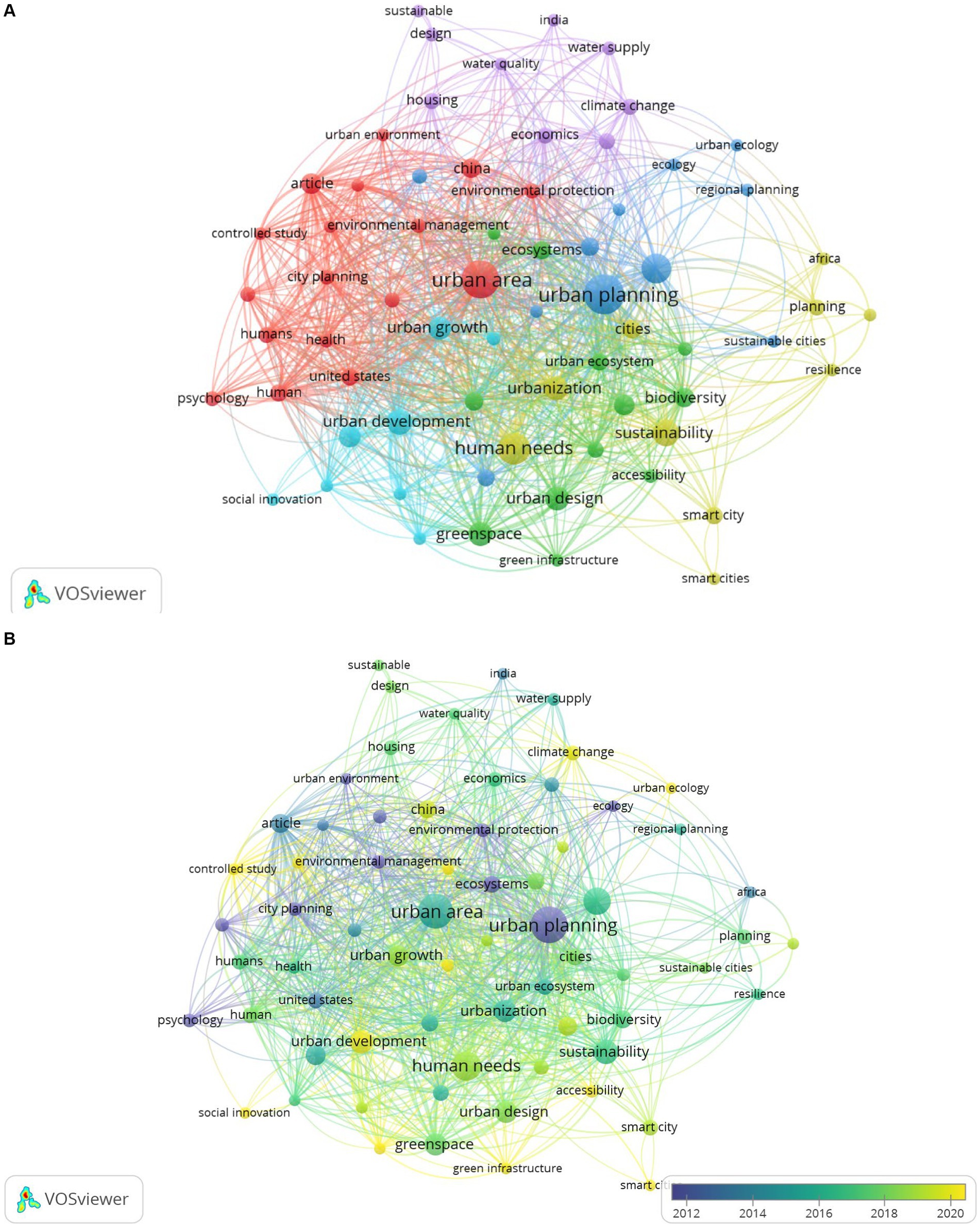
Figure 5. Clustering of the co-occurrence network based on different clusters (A) and evolution over time (B).
The co-occurrence analysis network was divided into six clusters, and the largest cluster (red color), which includes urban area, city planning, human and psychology, is shown in Figure 5A. In addition, the blue cluster includes urban planning and sustainable cities and urban ecology. The third cluster (green color) is urban design, greenspaces, biodiversity, urban ecosystem, accessibility, and green infrastructure. The fourth (yellow color) emphasizes human needs, urbanization, sustainability, and smart cities. Figure 5B highlights the evolution of the co-occurrence analysis network over time, which demonstrates the applications of urban development and human needs.
3.3.2 Thematic analysis
The four quadrants of the thematic map—niche themes, emerging or declining themes, motor themes, and basic themes—can easily plot and group the keywords to identify research themes Figure 6. The keywords “civil society,” and “cemetery,” are presented as niche themes. Nevertheless, the keywords “smart city,” “architecture design,” “environmental technology,” “sustainability,” and “urban transportation” are presented as emerging, despite their importance. In contrast, the keywords “ecosystems,” “biodiversity,” “urban area,” and “human needs” were considered motor themes, which reflect well-developed and important themes. In contrast, “urban planning,” “sustainable development,” “urban development,” “greenspaces,” “urbanization,” and “sustainability” reflected basic themes.
According to the thematic analysis, further efforts are required to develop important issues like “urbanization” and “smart cities,” in addition to “urban area” in “urban planning” and their related effects on achieving human needs. Additionally, despite its importance, the most popular terms did not sufficiently repeat the “geometric parameters” technique. Thus, additional study is required to investigate and apply such issues.
3.3.3 Most cited publications
Co-citation analysis was identified for the most globally cited publications, as shown in Figure 7. The top 10 articles have also been compiled in Table 1. The first, third, and tenth positions of the most cited application with 1,573, 454, and 83 citations, respectively, address the importance of urban nature for citizens (Thompson, 2002; Chiesura, 2004; Zwierzchowska et al., 2018). The publication ranks second and seventh position publications with 601 and 130 citations, respectively, identifying major challenges to managing biodiversity and ecosystem service and its effect on humans (Jansson, 2013; Aronson et al., 2017). The fourth-position publication with 354 citations was based on how the built environment contributes to the satisfaction of human needs (Tweed and Sutherland, 2007). On the other hand, the fifth and eighth positions with 224 and 117 citations, respectively, assess the ecosystem health of urban landscapes based on ecosystem services (Peng et al., 2015). The sixth and ninth positions with 171 and 109 citations examine supplies of water as human needs (Anderson, 2003; McKenzieb and Raya, 2009).
Based on an examination of the most widely cited publications, overall, good consistency could be observed between the results of co-citation for references and the co-occurrence of the analysis of the keyword.
3.3.4 The impact and network of authors
In accordance with the author’s impact concerning the total number of citations, Ardill N., Elshater A., Ismail S., Lix, and Yang Z. are the most cited authors, as shown in Figure 8A with three total citations in the research scope. However, concerning the authors’ H-index, Ismail S., obtained the greatest value, followed by Aaof Kaz, Kash C., Chiesura A., Dietrich U., and Friedmann J. with an H-index of 2, as shown in Figure 8B.
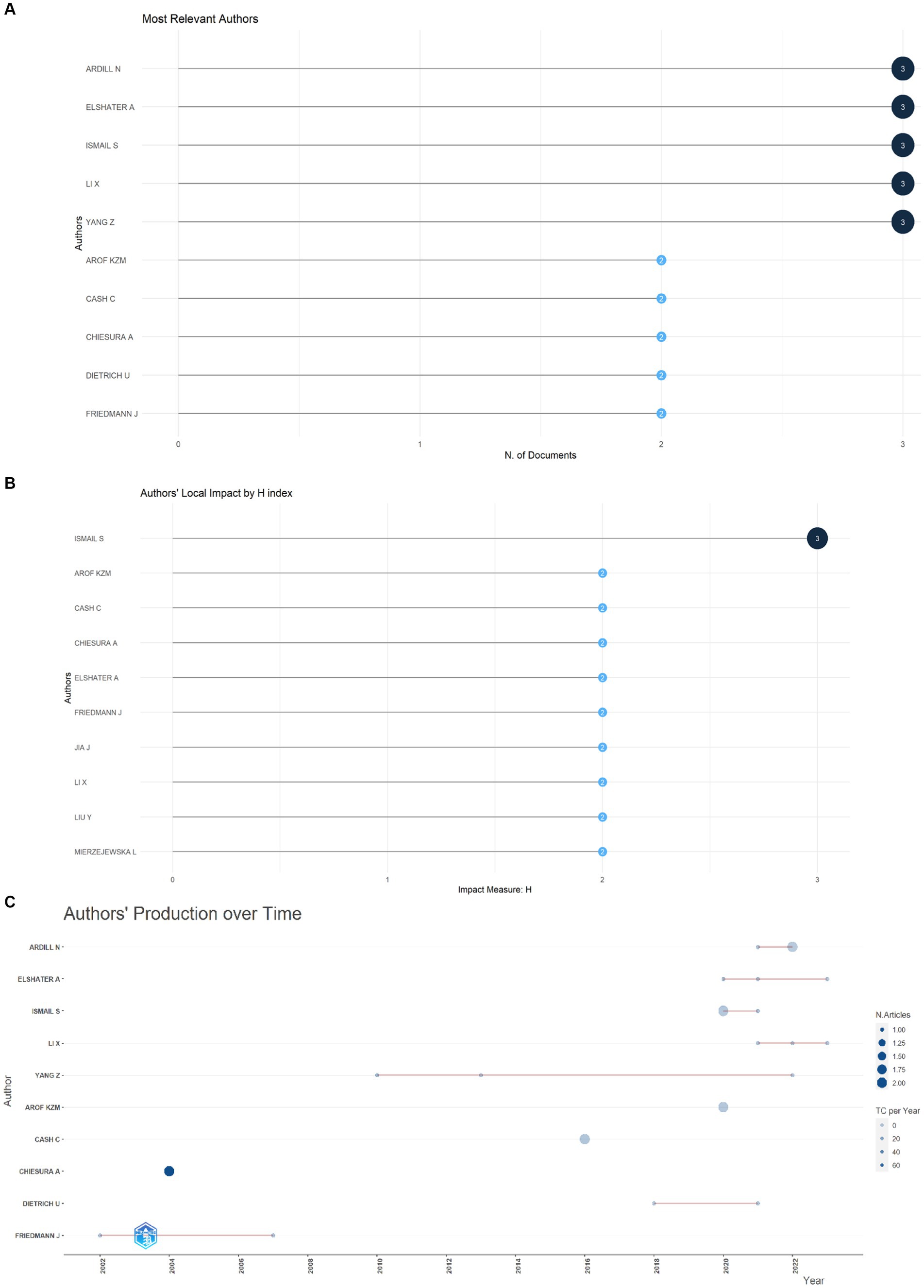
Figure 8. Bibliometric analysis of the top 10 authors: (A) total citations; (B) H-index; (C) production over years.
Figure 8C shows the output of the top 10 authors over time, with the number of papers (circle size) and the total number of citations (circle color) every year. For Ardill N., a lecturer in the School of Architecture at the University of Brighton, and Fellow of the Higher Education Academy, and a professor of Urban Morphology at Ain Shams University (ASU), Cairo, Egypt, their documents in the research scope presented a greater number, so were the most productive authors. On the other hand, the size of the circles can be defined by the number of citations per 50 authors, which highlights the significance of the authors’ network, as illustrated in Figure 9. The lines between the authors indicate linkages. The author’s network included 18 clusters. The most cited authors in each cluster were Yang Z. (119 citations), Zlatanova S. (119 citations), Ismail S. (54 citations), Elshater A. (19 citations), and Mierzejewska I. (14 citations).
3.3.5 The network of source
The top 10 sources in the network that frequently published previous research can be used as an accurate indicator of a publication’s credibility. The total number of citations of the top 10 sources according to the number of documents is shown in Figure 10, the journal Sustainability (Switzerland) came in first with seven citations, followed by the Journal of Landscape and Urban Planning with five citations.
3.3.6 The network of countries
By using bibliographic coupling, it is possible to identify the countries that have made significant contributions to the research field, which sheds more light on the topic and explains why that specific method of study had been developed. In this context, based on the number of documents, Figure 11 shows the top countries in the research sector.
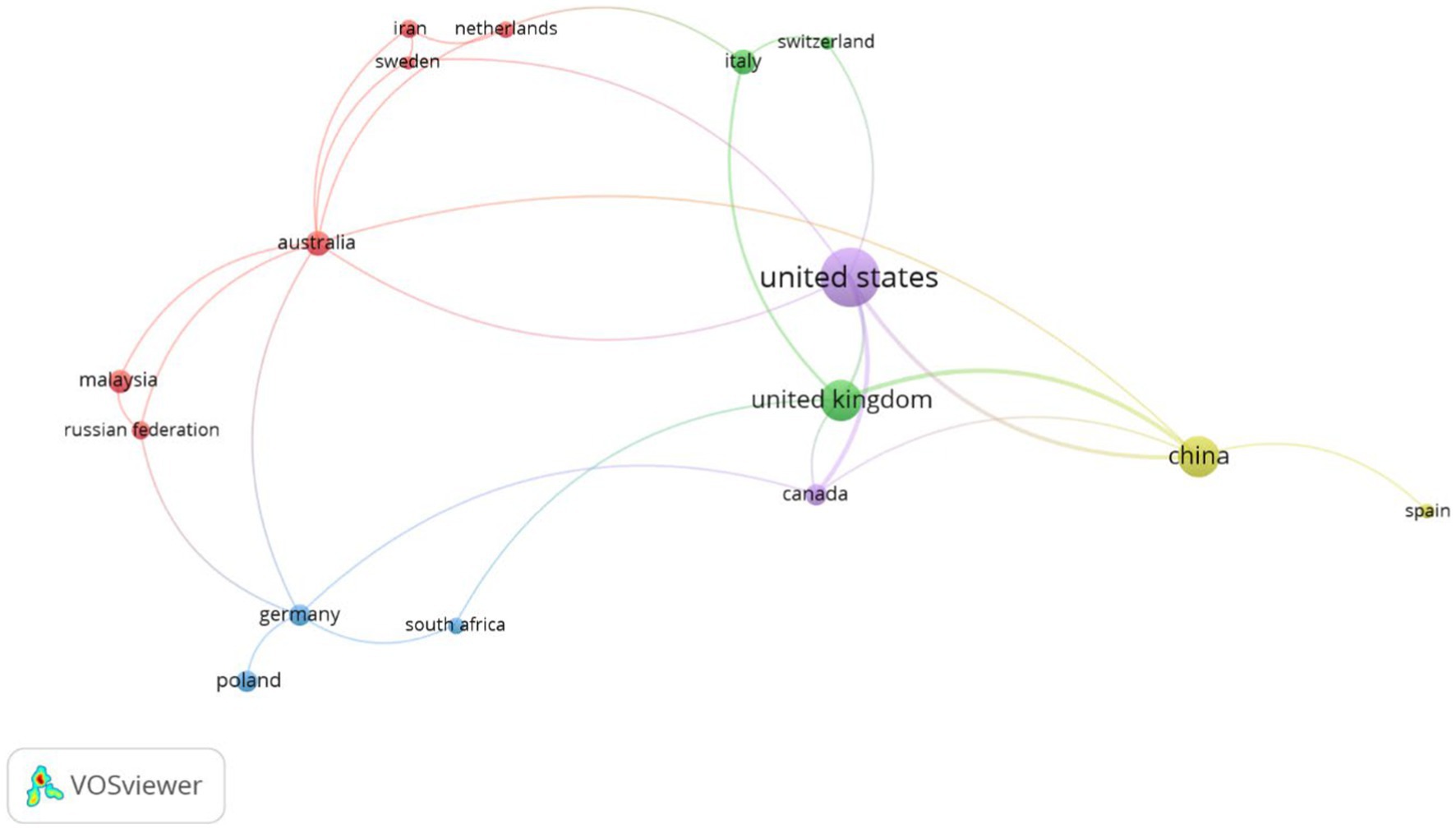
Figure 11. Bibliometric analysis of the most prominent countries’ networks by the number of documents. Source: Author.
The size of each node reflects how many documents each country has published. According to the results, the United States completed 36 documents with 1,221 citations, China completed 23 documents with 493 citations, the United Kingdom completed 23 documents with 1,644 citations, Australia completed 12 documents with 268 citations, and Canada completed 10 documents with 689 citations. Three clusters formed, providing the number of publications: red cluster including (six items), green cluster (three items), and blue cluster (three items).
3.3.7 Annual scientific production
Figure 12 illustrates the distribution by years of human needs in urban cities studies publications between 1964 and 2023. Increasing productions in the last 20 years where, in 2023 and 2021, 20 and 40 and 20 publications were published on the other hand, In the period between 1960 and 2011, the number of publications did not exceed five publications per year.
3.4 Classification of publications
By classifying published research on human needs and urban cities into four basic classifications based on search engines and study methods. It was found that 42 types of research can be classified into research based on Maslow’s theory of human needs, Max Neef’s theory, and applying human theories to a limited scope of urban components. The last classification is based on creating its classification, as shown in Table 2 and the timeline in Figure 13.
4 Theories of human needs
Human needs theories are a group of psychological and social theories that aim to explain the basic needs, desires, and motivations that drive human behavior (Doyal and Gough, 1991; Danesh, 2012). These theories indicate that some innate needs must be met for individuals to feel satisfied and accomplished in life. Human needs have been identified in many ways for human life in societies (Hallsmith, 2003). Table 3 shows a group of the most famous theories in studying human needs:
Comparing the above theories, it is clear that the ideas behind basic human needs are the most developed and relevant (Max-Neef, 1991), and more comprehensive, flexible, and functional (Papachristou and Rosas-Casals, 2019; Abubakar, 2022) as he explains human needs as an interconnected and interactive system (Guillen-Royo et al., 2017), unlike Maslow’s theory, which views needs as organized in a hierarchy and that they are built based on a measure of importance as Max Neef believes.
The following can be indicated:
• Human needs vary as individual motivations or as social requirements, according to the approach to be taken.
• The priority of these needs varies from one society to another. The priorities of industrial societies differ from capitalist societies from agricultural societies, in addition to the difference in needs according to societal cultures.
• Cities are complex networks of interactions between humans and their environment within the framework of various urban elements to achieve these needs at the individual and societal levels.
• Therefore, it was found that when studying human needs at the city level.
• It is truer to look at them as an interactive network, as Max Neve sees it, and not as hierarchical needs.
• Depending on the nature of the society being studied, the relative weights of these needs vary, but their availability as an interconnected network is essential for building a healthy society.
• The goal of achieving these needs is to satisfy human and societal desires to achieve satisfaction and stability.
Therefore, the needs and requirements presented by Max Neef are considered an entry point for creating a basis for identifying urban needs, which can be linked to theories of human needs. Max Neef’s theory can be highlighted as the closest; as it is based on integration between needs, it is based on the following points: understanding human needs and their complex interplay. An interactive, interconnected system. Needs are constant across all cultures and during different historical time periods but change is in the way these needs are met. Believes that one need is not more important than another need. There is no fixed order of precedence in the order of needs. It emphasizes the importance of social and environmental sustainability in addressing human needs.
While offering a comprehensive view of human needs, has some weaknesses to consider:
• The theory does not provide a clear framework for measuring need satisfaction across diverse populations.
• Limited focus on context: The theory does not explicitly account for external factors like social and economic inequalities that can significantly influence how needs are met.
• Focus on individual needs: The theory primarily focuses on individual needs. While acknowledging social connection as a need, it does not delve deeply into the dynamics of social structures and power relations that can affect need fulfillment.
By acknowledging the limitations, the theory can be used alongside other needs-based frameworks to create a more nuanced understanding of human motivation.
5 Components of urban cities
Cities are complex and dynamic systems (Fan and Zhang, 2023). Urban components are various facilities within the urban management public area (Zhang et al., 2019). Examining the components of urban planning reveals that numerous prominent publications and scholarly articles have drawn upon a common set of elements, albeit with evolving terminology through time; nevertheless, they all concur on the physical aspects embodied by infrastructure, buildings, roads, transportation, and public areas (Cuesta et al., 1990; Venables, 2007; Dempsey et al., 2008; Coyle and Duany, 2011; Forsyth, 2014; Wong et al., 2015; Howard et al., 2016; Fun et al., 2018; Bibri and Krogstie, 2019; Krisztián Nagy, 2022). Certain scholars have delved deeper into these components, particularly addressing the organization of sites, residential structures, pathways, streets, urban fabric, etc. Nonetheless, there is consensus that certain physical components are pivotal to the configuration and formation of a city, specifically infrastructure, transportation networks, buildings, public spaces, and land uses. The progression of contemporary urban planning trends, exemplified by the advocacy for human-centric cities and the promotion of intelligent, adaptable, resilient, eco-friendly, and sustainable urban areas, has necessitated the inclusion of additional criteria in city development to align with advancement and the anticipated urban landscape. Consequently, the study developed basic elements of cities for investigation, focusing on future human needs that change with sustainability. It outlined urban city elements considering physical and motivational factors, aiming to promote synergy among cities, humans, and the environment. This conceptual framework is illustrated in Figure 14.
6 Urban human needs
The cities function as a complex system comprising a variety of interconnected elements that interact with one another, with each component engaging in various interactions with multiple other elements. Despite the presence of established principles and standards guiding urban planning and the development of individual elements within it, there exists a lack of uniformity in the approach to defining its spatial voids, which varies from one location to another based on a range of factors such as the influence of cultural and social dynamics, the unique requirements of each void, and the specific spatial and geographic conditions at play. This variability results in a degree of flexibility in the design and planning of the city’s elements and their interconnections.
From this point of view, it has created a convergence point for understanding urban needs by linking them to the components of urbanization by building a theoretical framework for the study of human needs based on:
• Flexibility in identifying human needs, where it must be a series that is capable of multiple interpretations with changing times.
• These needs should be integrated and interconnected, and not each one individually.
• They should consider cultural and spatial changes.
• They should also consider the different requirements from one person to another and cover all human needs as much as possible.
Many theories of human needs are addressed in various ways with different indicators, but through the previous discussion of theories of human needs, we find that Max Neef’s theory, in general, provides a strong foundation to build on, but it needs some additions to address the shortcomings of considering the influence of the social and cultural context and taking into account individual and social needs and the dynamic, changing nature of needs, which allows us to have a deeper understanding of human needs and the possibility of achieving them in addition to identify an entry point that caters to human necessities using the urbanization elements. Upon analyzing the constituents of the urban environment, we observe them as interconnected parts, making it impractical to develop a cohesive cityscape in isolation without the presence of all essential elements for human needs. So, the urban human needs (UHN) framework serves as a structured approach aimed at elucidating the essential requirements of individuals that must be met, effectively establishing a connection between these needs and the various components within urban settings. This framework ultimately strives to facilitate the development of an interconnected urban environment that is capable of satisfying the aspirations and necessities of the populace. The formulation of this framework involved a meticulous process of extracting the fundamental UHN elements based on the above, human urban needs were formulated as shown in Figure 15.
Figure 16 shows the components of urban needs based on Max Neef’s human needs, which consist of 12 components: subsistence (existence), health and safety, identity and belonging, creativity and innovation, leisure, knowledge, freedom, flexibility and renewal, self-esteem, power, relationships and participation and justice.
7 Results and discussion
The results of this study can be divided into two sections.
7.1 Results of bibliometric analysis
Through bibliometric analysis, the results showed:
• In recent years, there has been increasing interest in studying the relationship between urbanization and human needs, but the research output is insignificant. This indicates the worsening of the problem of neglecting human needs in the planning process due to changing modern urban trends and their neglect of this aspect. Consequently, there is a need for a system that integrates human needs into urban planning to address this issue. Studies focused on studying human needs from the perspective of human needs theories in psychology and sociology, such as Maslow’s theory and Max Neve’s theory, without determining their suitability to urban needs.
• Interest in this field and the study of human needs has increased in large cities such as China and the United States. Despite technological advancements, this indicates the impact of technology on urbanization in these countries and its neglect of human needs. The decline in studies of human needs and their relationship to urbanization in developing countries has been noted. When reviewing available studies, it was found that studies still did not reach the maturity level to comprehensively reach a concept of human needs, as they were limited to studying necessities such as housing and water.
• Analytical research studies found that the concept of human needs represents a change over time and that human needs differ as time passes. No study completely agrees with the other in terms of the urban needs that should be provided. This indicates the necessity of considering flexibility in determining needs. Where the city is an integrated system; therefore, a comprehensive study of its needs and the presence of an integrated approach that represents the system of human needs in urbanization are essential.
7.2 Creating a new theory of urban human needs
Many theories of human needs address human needs in different ways and with different indicators, as shown in Table 3. Despite the multiplicity of theories of human needs, previous studies relied in their studies on only two theories: (Maslow’s Hierarchy of Needs and Max Neef’s Theory), as shown in Table 2. While ignoring the shortcomings of these theories and their suitability for measuring human needs at the city level.
To make up for these shortcomings, UHN’s theory was based on adopting Max Neef’s theory and integrating it with previous theories within the framework of human needs in cities.
The concept of Max Neef’s theory was adopted, which is based on the integration and interaction between needs and the interconnection between them, and then its nine elements were developed to cover all aspects of human needs at the level of cities, based on an analysis of the human needs that were addressed and focus on context, dynamic needs, integration with other theories, and an analysis of the concept of each component of city construction, in order to create a theory. It addresses human needs more comprehensively.
7.3 Feedback between the new theory and the components of the urban city
As shown in Figure 17, The city is an interaction between humans and the built environment within a specific environment. This research focuses on studying humans through their needs and the possibility of meeting them through the elements of the built environment. The relationship between human needs and the city is reciprocal, as human needs must be fulfilled through all elements of the city to have a decent and comfortable life. There must be good urban planning that fulfills all human needs through the components of the city to obtain an ideal layout that meets the needs of its users.
Illustrating the concept of feedback between the human needs of the city and the components of the city is what Figure 17 accomplishes. The UHN was attained by delving into theories of human needs in psychology and the components of urbanization. When this theory is applied to urbanization, it generates indicators and methodologies aimed at realizing the theory on the ground. Consequently, a feedback process is initiated through urbanization on the theory of urban human needs, working toward enhancing and refining the theory. For example, the application of urban human needs can be linked to the various components of urbanization in public spaces. Designing parks and plazas in a manner that promotes interaction and learning is essential, whether through workshops, community gardens, or public art displays. Creating spaces that facilitate diverse cultural expressions, such as street performances or ethnic festivals, plays a crucial role in fostering a sense of belonging and identity. This can be aligned with the SDT principles focusing on autonomy, competence, and relatedness. Within urban infrastructure, it is imperative to implement reliable and accessible public transportation systems to enhance independence and freedom of movement. Investing in skill-building programs and providing co-working spaces can empower residents to develop their competencies and work toward entrepreneurial endeavors. Moreover, facilitating community events and activities that promote interaction and social connections is vital, drawing from insights of both theories and focusing on housing. Developing mixed-use communities with various housing options is essential to cater to diverse needs and income levels, ultimately fostering a sense of belonging. Promoting resident involvement in neighborhood planning and design processes can increase autonomy and instill a sense of ownership over the urban environment. Leveraging technology for needs fulfillment, such as using online learning platforms for “Understanding” or civic engagement apps for “Participation,” can be a valuable strategy. Creating a diverse and accessible job market is crucial in providing residents with opportunities to fulfill their needs for “Subsistence” and potentially “Power” through economic success. Designing cities with a focus on environmental sustainability can promote healthy lifestyles and minimize environmental impact, thereby addressing the need for “Health” and potentially “Transcendence” through a connection with nature. By strategically applying these principles to various aspects of urbanization, cities can evolve into more supportive environments that cater comprehensively to the diverse needs of their residents, thereby promoting well-being and fostering a stronger sense of community.
UHN is a framework that clarifies the human needs that need to be achieved and links them to the urban components to create an integrated urbanization that fulfills the desires of the population. The research presented a general framework to guide planners to plan cities according to human needs (i.e., cities for humans) within the framework of future trends to suit the changes created, these needs were represented through a general framework representing 12 needs that are interactive and interconnected with each other, and it is necessary to strive to cover these needs as much as possible through the components of city construction.
Based on the previous analysis of the bibliometric analysis and a comprehensive review of various configuration parameters related to human needs and urban cities, researchers have shown a growing interest in the correlation between urbanization and human needs, but the research output is minimal, highlighting the neglect of human needs in planning due to modern urban trends. An integrated system is necessary to incorporate human needs into urban planning to tackle this issue. Studies have concentrated on human needs theories, especially in major cities like China and the United States. Despite technological advancements, there is a lack of focus on human needs in urbanization. Analytical research reveals that human needs evolve and vary among studies, emphasizing the need for flexibility in determining needs. Given that a city is a complex system, a thorough examination of its needs and an integrated approach to human needs in urbanization are crucial.
This framework subsequently necessitates an in-depth examination of the methodology to fulfill these requirements by considering each element individually.
In the end, this framework aims at:
• Covering all human needs through all elements of cities, aiming to improve the quality of urban life and achieve satisfaction from the population.
• It is considered a systematic thought to achieve future sustainability within the frameworks of smart cities and adapt them to serve humanity and not vice versa.
• This framework is primarily directed at serving people and achieving their desires. It is considered a future gateway to humanizing future smart cities.
Regarding the limitations, numerous potential restrictions must be taken into account. Primarily, the development of the database, a pivotal phase, laid the groundwork for this particular examination. On 22 December 2023, an exploration was carried out utilizing a restricted set of keywords within narrowly defined groupings, yielding specialized outcomes that lacked generalizability. Furthermore, a substantial quantity of literature was omitted from this study through the Scopus database, employing three criteria: categories, publication types, and language; or through manual scrutiny aligned with the aims and extent of the micro level, and the appropriateness of retaining articles relevant to the research subject.
This study strengthened the possibility of achieving human needs by formulating a new concept specializing in physical needs. This gives urban planners and designers an opportunity to be guided in city planning and can be developed by researchers through applied studies on cities.
8 Conclusion
Humanizing cities is a way to achieve human needs through urbanization and create integrated urbanism. The research focused on the human angle by focusing on his needs, meeting them, and linking them to the elements of urbanization through several steps: using bibliometric analysis (Biblioshiny and VOSviewer) and finding the extent of researchers’ interest in this field and its impact. Then addressing the research gap in previous studies and highlighting the importance of integrating human needs into urbanization plans. Then criticize the theories of human needs in psychology, develop Max Neef’s theory of human needs, and generate urban human needs (UHN). And prove that these needs are interrelated and must be fulfilled according to their importance, without dispensing with one of them, to achieve human balance. It then presents a framework that presents the human needs that must be fulfilled through urbanization.
The importance of this research lies in the fact that it represents a preliminary stage that draws a vision of future human needs at the level of urbanization and a basis on which future urban planning can be based. This research opens new horizons to study how to achieve HUN human needs through urban elements and create indicators and criteria that measure the extent to which human needs are achieved, which provides the key to developing and building more humane cities capable of understanding human needs in the cities in the future.
Data availability statement
The raw data supporting the conclusions of this article will be made available by the authors, without undue reservation.
Author contributions
SSA: Conceptualization, Data curation, Formal analysis, Funding acquisition, Investigation, Methodology, Project administration, Resources, Software, Supervision, Validation, Visualization, Writing – original draft, Writing – review & editing.
Funding
The author(s) declare that no financial support was received for the research, authorship, and/or publication of this article.
Conflict of interest
The author declares that the research was conducted in the absence of any commercial or financial relationships that could be construed as a potential conflict of interest.
Publisher’s note
All claims expressed in this article are solely those of the authors and do not necessarily represent those of their affiliated organizations, or those of the publisher, the editors and the reviewers. Any product that may be evaluated in this article, or claim that may be made by its manufacturer, is not guaranteed or endorsed by the publisher.
References
Abubakar, A. (2022). Towards a human-centred approach for enhancing place prosperity: defining and operating within the basic human needs. Open House Int. 47, 190–206. doi: 10.1108/OHI-12-2020-0171
Aktaş, N. K., and Dönmez, N. Y. (2021). An urban paradox: urban resilience or human needs Design of Cities and Buildings: Sustainability and Resilience in the Built Environment, 173.
Aliyeva, Z., Assipova, Z., Bazarbekova, M., Mussagaliyeva, A., and Sansyzbayeva, A. (2019). Urban area planning and environment in Kazakhstan’s cities: case of Almaty. Int. Multidiscip. Sci. GeoConference Surv. Geol. Min. Ecol. Manag. 19, 775–782. doi: 10.5593/sgem2019/5.2/S20.097
Alperyte, I. (2006). Cultural needs of Lithuanian inhabitants in the context of global consumer culture. Transform. Bus. Econ. 5, 122–135.
Anderson, J. (2003). The environmental benefits of water recycling and reuse. Water Sci. Technol. Water Supply 3, 1–10. doi: 10.2166/ws.2003.0041
Arof, K. Z. M., Ismail, S., Najib, N. H., Amat, R. C., and Ahmad, N. H. B. (2020a). Exploring opportunities of adopting biophilic cities concept into mixed-use development project in Malaysia. IOP Conf. Ser. Earth Environ. Sci. 409:012054. doi: 10.1088/1755-1315/409/1/012054
Arof, K. Z. M., Ismail, S., Subramaniam, C., Azman, S., Rani, W. N. M. W. M., and Zolkepli, M. F. (2020b). Critical strategies for construction players in the adoption of biophilic city concept in Malaysia. Plan. Malays. 18, 181–192. doi: 10.21837/pm.v18i11.719
Aronson, M. F. J., Lepczyk, C. A., Evans, K. L., Goddard, M. A., Lerman, S. B., MacIvor, J. S., et al. (2017). Biodiversity in the city: key challenges for urban green space management. Front. Ecol. Environ. 15, 189–196. doi: 10.1002/fee.1480
Beck, M. B., and Villarroel Walker, R. (2013). Nexus security: governance, innovation and the resilient city. Front. Environ. Sci. Eng. 7, 640–657. doi: 10.1007/s11783-013-0549-5
Bibri, S. E., and Krogstie, J. (2019). Generating a vision for smart sustainable cities of the future: a scholarly backcasting approach. Eur. J. Futures Res. 7:5. doi: 10.1186/s40309-019-0157-0
Brand-Correa, L. I., Martin-Ortega, J., and Steinberger, J. K. (2018). Human scale energy services: untangling a ‘golden thread’. Energy Res. Soc. Sci. 38, 178–187. doi: 10.1016/j.erss.2018.01.008
Bris, A. (2019). Smart cities: world’s best don’t just adopt new technology, they make it work for people. Available at: https://theconversation.com/smart-cities-worlds-best-dont-just-adopt-new-technology-they-make-it-work-for-people-124939#. (Accessed 30 October, 2020)
Bunkse, E. V. (1979). The role of a humane environment in Soviet urban planning. Geogr. Rev. 69, 379–394. doi: 10.2307/214802
Caprotti, F. (2018). Future cities: moving from technical to human needs. Palgrave Commun. 4:35. doi: 10.1057/s41599-018-0089-5
Cardoso, R., Sobhani, A., and Meijers, E. (2022). The cities we need: towards an urbanism guided by human needs satisfaction. Urban Stud. 59, 2638–2659. doi: 10.1177/00420980211045571
Çelikyay, H. S. (2020). “Empathic design approach to public space organization in the urban environment” in Theory and practice in sustainable planning and design.
Chiesura, A. (2004). The role of urban parks for the sustainable city. Landsc. Urban Plan. 68, 129–138. doi: 10.1016/j.landurbplan.2003.08.003
Coyle, S., and Duany, A. (2011). Sustainable and resilient communities: a comprehensive action plan for towns, cities, and regions.
Cuesta, R., Sarris, C., Signoretta, P., and Moughtin, J. C. (1990). Urban design: method and techniques.
Dempsey, N., Brown, C., Raman, S., Porta, S., Jenks, M., Jones, C., et al. (2008). Elements of urban form, 21–51.
Dietrich, U. (2021). Space needed to make a city sustainable and necessary changes to reach it: the case of Germany. WIT Trans. Ecol. Environ. 253, 229–240. doi: 10.2495/SC210201
Doyal, L., and Gough, I. (1991). A theory of human need. Crit. Soc. Policy 4, 6–38. doi: 10.1177/026101838400401002
Drakakis-Smith, D. (1997). Third world cities: sustainable urban development IIIÐ basic needs and human rights. Urban Stud. 34, 797–823. doi: 10.1080/0042098975835
Fun, S. L., Christiaanse, K., Cairns, S., Richthofen, A. V., Leyk, D., Knecht, K., et al. (2018). Urban Elements: Advanced Studies in Urban Design. Zürich, Switzerland: ETH Zürich, Department of Architecture.
Fan, C., Xu, J., Natarajan, B. Y., and Mostafavi, A. (2023). Interpretable machine learning learns complex interactions of urban features to understand socio-economic inequality. Comput. Aided Civ. Inf. Eng. 38, 2013–2029. doi: 10.1111/mice.12972
Fan, L., and Zhang, D. (2023). Study on the hotspots of urban tourism spaces based on Instagram-worthy locations data: taking Beijing as an example. Environ. Plan. B 50, 1822–1837. doi: 10.1177/23998083221146542
Forsyth, A. (2014). The urban design handbook: techniques and working methods (2nd ed.), by Urban Design Associates. J. Am. Plan. Assoc. 80, 448–449. doi: 10.1080/01944363.2014.998135
Gibbs, D., Krueger, R., and MacLeod, G. (2013). Grappling with smart city politics in an era of market triumphalism. Urban Stud. 50, 2151–2157. doi: 10.1177/0042098013491165
Gimelli, F. M., Rogers, B. C., and Bos, J. J. (2019). Linking water services and human well-being through the fundamental human needs framework: the case of India. Water Altern. 12, 715–733.
González-Méndez, M., Olaya, C., Fasolino, I., Grimaldi, M., and Obregón, N. (2021). Agent-based modeling for urban development planning based on human needs. Conceptual basis and model formulation. Land Use Policy 101:105110. doi: 10.1016/j.landusepol.2020.105110
Greenbie, B. B. (1978). A model for accommodating the human need for small scale communities within the context of global cooperative systems. Urban Ecol. 3, 137–153. doi: 10.1016/0304-4009(78)90004-9
Greene, S. (1992). City shape: communicating and evaluating community design. J. Am. Plan. Assoc. 58, 177–189. doi: 10.1080/01944369208975792
Gu, X., Xu, D., Xu, M., and Zhang, Z. (2022). Measuring residents’ perceptions of multifunctional land use in peri-urban areas of three Chinese megacities: suggestions for governance from a demand perspective. Cities 126:103703. doi: 10.1016/j.cities.2022.103703
Guillen-Royo, M., Guardiola, J., and Garcia-Quero, F. (2017). Sustainable development in times of economic crisis: a needs-based illustration from Granada (Spain). J. Clean. Prod. 150, 267–276. doi: 10.1016/j.jclepro.2017.03.008
Hallsmith, G. (2003). The key to sustainable cities: meeting human needs, transforming community systems. Gabriola Island: New Society Publishers.
Howard, E., Burgess, E. W., Corbusier, L., Mumford, L., Jacobs, J., Wirth, L., et al. (2016). The City Reader. 6th Edn.
Hurly, J., and Walker, G. J. (2019). Nature in our lives: examining the human need for nature relatedness as a basic psychological need. J. Leis. Res. 50, 290–310. doi: 10.1080/00222216.2019.1578939
Illia Ibrahim, F., and Diyana Nizarudin, N. (2019). Human interaction theory for sustainable city. IOP Conf. Ser. Earth Environ. Sci. 268:012046. doi: 10.1088/1755-1315/268/1/012046
Jansson, T. (2013). Reaching for a sustainable, resilient urban future using the lens of ecosystem services. Ecol. Econ. 86, 285–291. doi: 10.1016/j.ecolecon.2012.06.013
Ji, T., Chen, J.-H., Wei, H.-H., and Su, Y.-C. (2021). Towards people-centric smart city development: investigating the citizens’ preferences and perceptions about smart-city services in Taiwan. Sustain. Cities Soc. 67:102691. doi: 10.1016/j.scs.2020.102691
Kochtitzky, C. S., Frumkin, H., Rodriguez, R., Dannenberg, A. L., Rayman, J., Rose, K., et al. (2006). Urban planning and public health at CDC. MMWR Morb. Mortal Wkly. Rep. 55, 34–38.
Krisztián Nagy, D. (2022). Hinterlands, city formation and growth: evidence from the U.S. westward expansion. Rev. Econ. Stud. 90, 3238–3281. doi: 10.1093/restud/rdad008
Lam, S., Li, H., and Yu, A. T. W. (2021). A demand-side approach for linking the past to future urban-rural development. Urban Plan. 6, 162–174. doi: 10.17645/up.v6i2.3798
Liu, L., and Tan, S.-K. (2010). Functional analysis of the land-use system in urban residential areas. 2010 International Conference on E-Business and E-Government, 5191–5194
Luckan, Y. (2021). “Defining the layers of urban complexity: an epistemological shift towards inclusive cities” in Urban inclusivity in southern Africa: the urban book series.
Maclean, A. (1983). “Human need and community initiatives in an urban setting” in Canterbury at the crossroads.
March, H., and Ribera-Fumaz, R. (2016). Smart contradictions: the politics of making Barcelona a self-sufficient city. Eur. Urban Reg. Stud. 23, 816–830. doi: 10.1177/0969776414554488
Marvi, L. T., Behzadfar, M., and Shemirani, S. M. M. (2023). Defining the social-sustainable framework for smart cities. Int. J. Hum. Cap. Urban Manag. 8, 95–110. doi: 10.22034/IJHCUM.2023.01.08
Max-Neef, M. (1991). Human scale development: conception, application and further reflections. New York and London: The Apex Press.
Max-Neef, M. (1992). “Development and human needs” in Real-life economics: understanding wealth creation (London: Routledge), 197–213.
McKenzieb, D., and Raya, I. (2009). Urban water supply in India: status, reform options and possible lessons. Water Policy 11, 442–460. doi: 10.2166/wp.2009.056
Mutică, A. P. (2013). “Architecture and human needs” in Acta technica napocensis: civil engineering & architecture.
Neufeld, C., and Wohl, S. (2022). “Experiments in living together” in Future urban habitation: transdisciplinary perspectives, conceptions, and designs.
Palmer, H., Simon, D., and Riise, J. (2022). Urban research for sustainability: developing a comparative transdisciplinary co-production approach to realise just cities. Int. J. Sustain. Dev. 25, 78–94. doi: 10.1504/ijsd.2022.126473
Papachristou, I. A., and Rosas-Casals, M. (2019). Maximising the degree of user choice: a simple tool to measure current levels of quality of life in urban environments. Urban Plan. 4, 207–222. doi: 10.17645/up.v4i2.2006
Peng, J., Liu, Y., Wu, J., Lv, H., and Hu, X. (2015). Linking ecosystem services and landscape patterns to assess urban ecosystem health: a case study in Shenzhen City, China. Landsc. Urban Plan. 143, 56–68. doi: 10.1016/j.landurbplan.2015.06.007
Rodrigues, J. P. C. (2018). Local government aimed at quality of life in sustainable cities Entrepreneurial, Innovative and Sustainable Ecosystems. Applying Quality of Life Research. Springer, Cham 35–53)
Rodzoś, J. (2019). The concept of human needs in sustainable development of cities | Teoria potrzeb ludzkich w rozwoju zrównoważonym miast. Problemy Ekorozwoju 14, 91–99.
Rossi, U. (2016). The variegated economics and the potential politics of the smart city. Territ., Politics, Gov. 4, 337–353. doi: 10.1080/21622671.2015.1036913
Saloma, C., and Akpedonu, E. (2021). Parks, plans, and human needs: Metro Manila’s unrealised urban plans and accidental public green spaces. Int. J. Urban Sustain. Dev. 13, 715–727. doi: 10.1080/19463138.2021.2021418
Santoni,, Siahaan, U., and Tobing, R. R. (2023). Relocating illegal urban settlements and fulfilling the human needs through physical order: an evaluation of the Marunda flats in Jakarta, Indonesia. ISVS E-J. 10, 56–75.
Santos, L. D., and Martins, I. (2007). Monitoring urban quality of life: the porto experience. Soc. Indic. Res. 80, 411–425. doi: 10.1007/s11205-006-0002-2
Seliverstov, S., Seliverstov, Y., Gavkalyk, B., and Fahmi, S. (2020). Development of transport infrastructure organization model for modern cities with growing effectiveness. Transp. Res. Procedia 50, 614–625. doi: 10.1016/j.trpro.2020.10.073
Sheikh, W. T., and van Ameijde, J. (2022). Promoting livability through urban planning: a comprehensive framework based on the “theory of human needs”. Cities 131:103972. doi: 10.1016/j.cities.2022.103972
Shrestha, S. B., and Taniguchi, O. (2003). A holistic approach for providing affordable housing to the urban poor of Nepal. J. Asian Archit. Build. Eng. 2, 153–160. doi: 10.3130/jaabe.2.153
Su, M., Fath, B. D., and Yang, Z. (2010). Urban ecosystem health assessment: a review. Sci. Total Environ. 408, 2425–2434. doi: 10.1016/j.scitotenv.2010.03.009
Tay, L., and Diener, E. (2011). Needs and subjective well-being around the world. J. Pers. Soc. Psychol. 101, 354–365. doi: 10.1037/a0023779
Thompson, C. W. (2002). Urban open space in the 21st century. Landsc. Urban Plan. 60, 59–72. doi: 10.1016/S0169-2046(02)00059-2
Tweed, C., and Sutherland, M. (2007). Built cultural heritage and sustainable urban development. Landsc. Urban Plan. 83, 62–69. doi: 10.1016/j.landurbplan.2007.05.008
Venables, A. J. (2007). The dynamics of city formation: finance and governance. Available at: http://www.econ.brown.edu/faculty/henderson/
Wang, J., Hu, Y., Song, R., and Wang, W. (2022). Research on the optimal allocation of ecological land from the perspective of human needs—taking Hechi city, Guangxi as an example. Int. J. Environ. Res. Public Health 19:12418. doi: 10.3390/ijerph191912418
Wong, T.-C., Han, S. S., and Zhang, H. (2015). Population mobility, urban planning and management in China.
Ye, K., Luo, H., Zhong, H., and Kang, J. (2022). Physiological and psychological influence of multi-media in urban business districts. Sustain. Cities Soc. 77:103546. doi: 10.1016/j.scs.2021.103546
Zeng, W., Huo, X., and Yu, Z. (2020). Humanistic demand and spatiotemporal perspective in the evaluation of urban life quality—a case study of Shandong province in China. IOP Conf. Ser. Earth Environ. Sci. 580:012065. doi: 10.1088/1755-1315/580/1/012065
Zhang, H., Cheng, C., and Miao, S. (2019). A precise urban component management method based on the GeoSot grid code and BIM. ISPRS Int. J. Geo Inf. 8:159. doi: 10.3390/ijgi8030159
Keywords: human needs, urban components, future city, urban cities, urban human needs
Citation: Alsayed SS (2024) Urban human needs: conceptual framework to promoting urban city fulfills human desires. Front. Sustain. Cities. 6:1395980. doi: 10.3389/frsc.2024.1395980
Edited by:
Guoliang Xu, Jiangxi University of Finance and Economics, ChinaReviewed by:
Dastan Bamwesigye, Mendel University in Brno, CzechiaXinmin Zhang, Jiangxi University of Finance and Economics, China
Copyright © 2024 Alsayed. This is an open-access article distributed under the terms of the Creative Commons Attribution License (CC BY). The use, distribution or reproduction in other forums is permitted, provided the original author(s) and the copyright owner(s) are credited and that the original publication in this journal is cited, in accordance with accepted academic practice. No use, distribution or reproduction is permitted which does not comply with these terms.
*Correspondence: Shaimaa S. Alsayed, bXlzaGFhYWFyY2hAZ21haWwuY29t
†ORCID: Shaimaa S. Alsayed, https://orcid.org/0009-0008-1655-9390
 Shaimaa S. Alsayed
Shaimaa S. Alsayed
